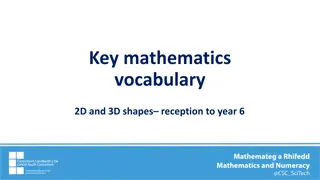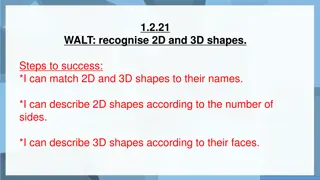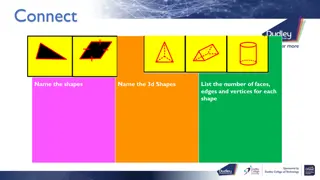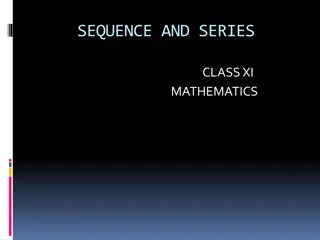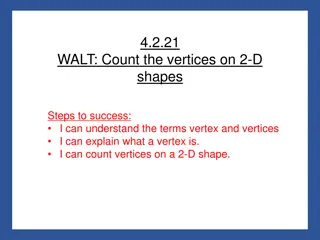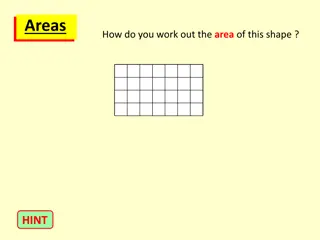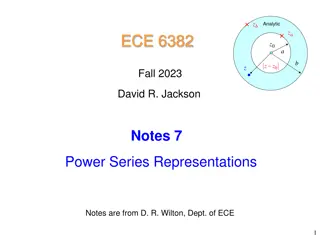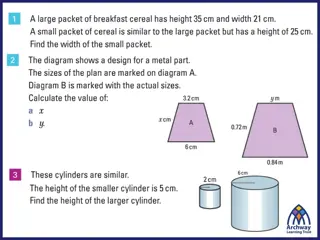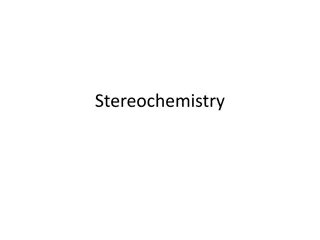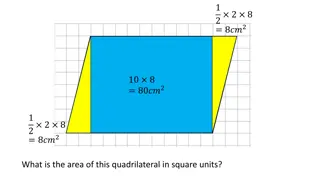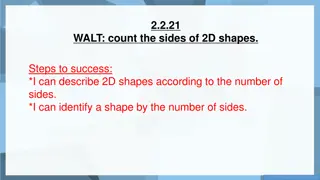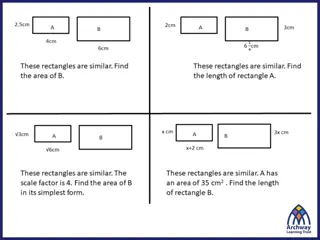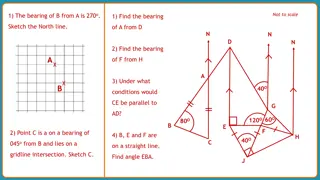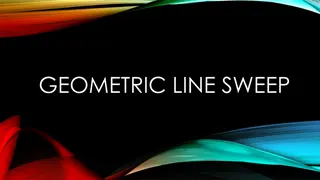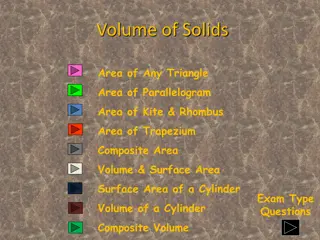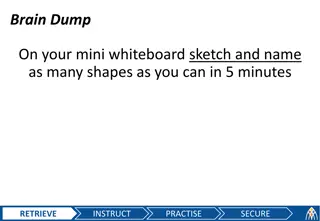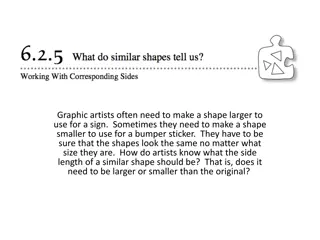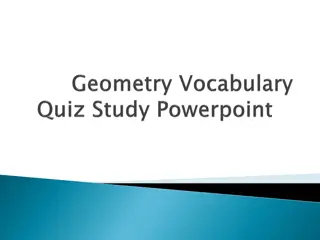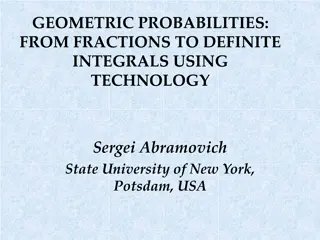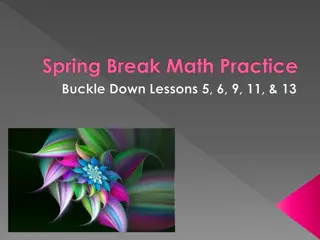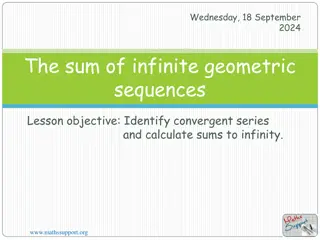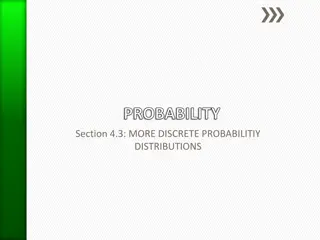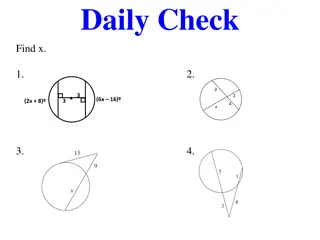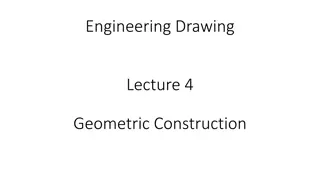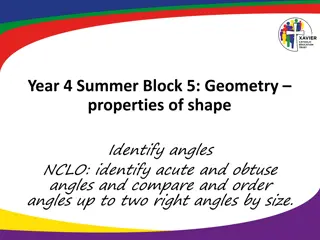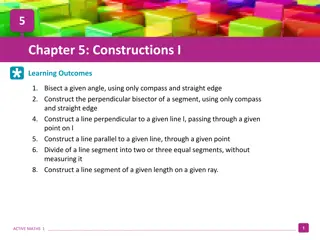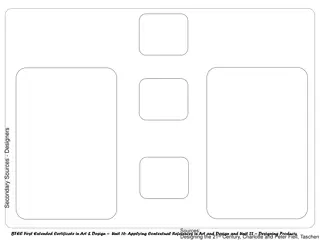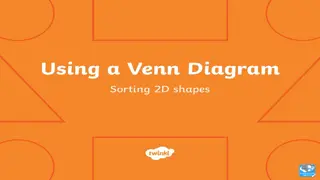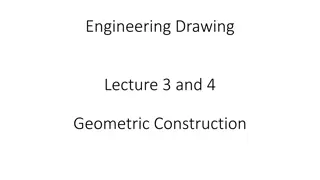2D and 3D Shapes with Nets and Properties
Dive into the world of 2D and 3D shapes with a focus on properties, edges, vertices, faces, and lines of symmetry. Discover how to draw nets for cubes and cuboids, identify shapes, name 3D shapes, and understand mathematical definitions. Engage in activities that challenge your knowledge of shapes a
0 views • 16 slides
Mastering 2D and 3D Shapes Vocabulary from Reception to Year 5
Explore essential 2D and 3D shapes vocabulary for students from reception to Year 5, encompassing a variety of shapes such as cubes, pyramids, spheres, cones, cylinders, and more. The comprehensive list includes both two-dimensional and three-dimensional shapes, providing a solid foundation for unde
4 views • 9 slides
Shapes Recognition Activities for Students
Explore various 2D and 3D shape recognition activities including matching shapes to names, identifying shapes based on sides and faces, and sorting shapes into categories. Engage in fluency exercises to name and match shapes, reasoning challenges, and problem-solving tasks to enhance shape recogniti
0 views • 12 slides
Geometric Shapes through Visualization in Mathematics for Class 7
Explore the concept of visualising solids in mathematics for Class 7 students. Learn to associate 2D drawings with 3D shapes, visualize various solids, identify their properties, and develop skills in drawing sketches. The chapter covers learning objectives, recapitulation of shapes around us, intro
2 views • 35 slides
Metric Units of Measurement in Mathematics
Explore the world of metric units in mathematics through the measurement of length, weight, and capacity. Learn about converting between units and applying these concepts to real-world scenarios. Discover the properties of shapes and delve into 3D shapes by counting faces, edges, and vertices. Engag
1 views • 21 slides
Sequences and Series in Mathematics
Sequences and series are fundamental concepts in mathematics, with sequences consisting of terms denoted as a1, a2, a3, ... and series involving the sum of terms in arithmetic and geometric progressions. Learn about arithmetic progression, geometric progression, terms, and formulas for finding sums
2 views • 11 slides
Mastering 2-D Shape Vertices: Learning Guide
Understand the concept of vertices on 2-D shapes, learn how to count vertices, identify shapes based on their vertices, and determine the odd one out in a group of shapes. Explore the number of vertices in various shapes like a triangle, rectangle, pentagon, hexagon, octagon, and even a circle. Test
5 views • 16 slides
Geometry Learning - Lines of Symmetry Activities
Explore various activities focused on lines of symmetry in shapes. Engage in identifying symmetrical shapes, finding lines of symmetry through folding, sorting shapes based on symmetrical properties, drawing lines of symmetry, and reasoning about symmetrical shapes. Enhance your understanding of sym
1 views • 16 slides
Calculate Area of Various Shapes - Geometry Challenges
Discover how to calculate the area of different shapes through hints and visual aids such as squares, rectangles, triangles, and more. Learn to find areas of composite shapes, missing triangles, and shapes with corners cut off. Practice working out areas based on dimensions provided in each scenario
0 views • 10 slides
Geometric Series: Power Series Representations & Convergence
Geometric series analysis discusses the summation, convergence, and divergent properties within and outside the unit circle. The series' representation, convergence conditions, and extensions are explored through power series expansions and geometric series summations, providing a comprehensive unde
0 views • 50 slides
Similarity and Congruence in Geometry
The difference between congruence and similarity lies in how shapes are compared. Congruent shapes are identical in size and shape, with equal side lengths and angles. Similar shapes have proportional side lengths and equal angles, appearing alike but not identical. Scaling factors play a crucial ro
1 views • 20 slides
Stereochemistry: Isomers and Their Properties
Stereochemistry explores the fascinating world of isomers, including stereoisomers, geometric isomers, and structural isomers. Stereoisomers have the same molecular formula but differ in spatial arrangement, while geometric isomers lack free rotation around bonds. Structural isomers like dimethyl et
0 views • 27 slides
Geometric Problems and Solutions
Explore various geometric problems related to quadrilaterals, rectangles, parallelograms, and tangrams. Learn about finding areas, transforming shapes, and solving puzzles. Discover the principles behind turning a rectangle into a parallelogram and identifying areas of different geometric figures.
0 views • 7 slides
2D Shapes and Sides in Mathematics
Dive into identifying and counting the sides of 2D shapes through informative practices like describing shapes by their sides, recognizing shapes by their side count, and solving engaging problems related to shapes and sides. Explore the properties of various polygons, such as squares, triangles, pe
0 views • 11 slides
Geometry Problem Solving and Volume Calculations
Solve challenging geometry problems involving spheres, cones, cylinders, and frustums. Calculate volumes, heights, and surface areas of various geometric shapes using proportional relationships and volume formulas. Explore concepts of mass, density, and similarity in geometric figures. Test your pro
0 views • 15 slides
Solving Bearings and Geometric Problems
This content discusses solving problems involving bearings, geometric shapes, and properties of triangles and lines. It covers determining bearings between points, finding angles in isosceles triangles, and understanding parallel lines and angles. The content also includes information on angles in q
0 views • 6 slides
Geometric Line Sweep Algorithms
Geometric Line Sweep is a powerful technique where an imaginary line sweeps over points, performing geometric operations at each point. This method can find minimum distances between points, overlapping rectangles, and more. By sorting points and efficiently processing them, it can enhance performan
0 views • 10 slides
Geometric Routing Concepts and Byzantine Fault Tolerance
Geometric Routing enables routing without overhead, where each node knows its global coordinates and forwards messages based on proximity to the destination. Byzantine Faults pose challenges with arbitrary node behavior, but a Byzantine-Robust Geometric Routing algorithm addresses this in a 3-connec
2 views • 33 slides
Geometric Formulas for Area of Various Shapes
Explore formulas for finding the area of different geometric shapes such as triangles, parallelograms, rhombuses, kites, and more. Learn how to calculate areas efficiently and apply them to solve problems with units. Utilize diagrams and examples to grasp the concepts effectively.
0 views • 39 slides
Engaging English Lesson on Shapes and Rhymes for Second Graders
Explore an interactive English lesson for second-grade students focusing on shapes and rhymes. The lesson includes activities such as safety greetings, reviewing previous lessons, and reciting rhymes about shapes like circles and squares. Students will enhance their listening and speaking skills by
0 views • 16 slides
Platonic Solids: Shapes of Harmony and Elements
Explore the fascinating world of Platonic solids, 3D shapes with faces made of regular polygons, each representing a different element. Dive into the history, symbolism, and unique characteristics of the tetrahedron, cube, octahedron, and dodecahedron through their elemental associations. Discover t
0 views • 12 slides
2D Shapes and Polygons
Uncover the world of 2D shapes and polygons with a brain dump session, identifying common shapes like triangles, quadrilaterals, and polygons with Greek and Latin numerical prefixes. Learn the distinguishing features of shapes, symbols used to represent key characteristics, and how markings denote e
0 views • 27 slides
Scale Factors and Similar Shapes in Graphic Design
Graphic artists often need to resize shapes for different purposes while ensuring they maintain their original proportions. This involves determining the scale factor between similar shapes, understanding how to find the scale factor using corresponding sides, and dealing with scenarios where sides
0 views • 8 slides
Geometric Shapes and Concepts Overview
Illustrations showcasing various geometric shapes and concepts including quadrilaterals with specific attributes, triangles with different angle measurements, endpoints and segments, and intersecting lines. Explore the visual representations to enhance your understanding of basic geometry.
0 views • 23 slides
Geometric Probabilities: From Fractions to Integrals
Delve into the realm of geometric probabilities with insights on how to transition from fractions to definite integrals, utilizing technology for enhanced learning experiences. Understand the significance of probability calculations in quantifying likelihood, incorporating geometric representations
0 views • 26 slides
Math Practice: Ratios, Proportions, Estimation, and Geometric Figures
Explore math concepts such as ratios, proportions, estimation, rounding, and geometric figures through engaging lessons and problem-solving scenarios. Practice using proportions to find missing values, round whole numbers and decimals, estimate costs, and learn about geometric shapes. Enhance your m
0 views • 19 slides
Infinite Geometric Sequences and Convergent Series
Explore the concept of infinite geometric sequences in mathematics through the example of cutting a string into halves. Learn how to identify convergent series and calculate sums to infinity, distinguishing between convergent and divergent series based on the common ratio. Delve into the formula for
0 views • 12 slides
Geometric and Poisson Probability Distributions
Explore the geometric and Poisson probability distributions, including criteria for geometric random variables, formulas, and practical examples. Learn how to calculate probabilities using the geometric distribution and apply it in scenarios like Russian Roulette and blood donor collection. Dive int
0 views • 13 slides
Geometric Concepts in Grade Five Mathematics
Dive into the world of geometry with Grade Five Mathematics! This module covers topics such as shapes classification, properties of two-dimensional and three-dimensional shapes, coordinate systems, polygon construction, and Van Hiele levels of geometric thought. Engage with hands-on activities, visu
0 views • 52 slides
Overview of Proposed Changes in Producer Price Index Formulas
The U.S. Bureau of Labor Statistics is considering transitioning from a modified Laspeyres formula to a geometric Young formula for elementary indexes in the Producer Price Index (PPI). This proposed change aims to enhance the accuracy and economic relevance of price measurements by utilizing a geom
0 views • 25 slides
Volume Formulas for Geometric Shapes
Exploring the concepts of volume calculation for various geometric shapes like cylinders, prisms, cones, and pyramids. Learn about the formulas, properties, and relationships between different parts of these shapes. Visual aids and step-by-step explanations provided for better understanding.
0 views • 28 slides
Bee-Friendly Flowers and Nectar Preferences
Leafcutter bees are busy making nests this month, highlighting the importance of flowers in attracting different bee species based on shapes, nectar availability, and tongue lengths. Different bees prefer various flower shapes for nectar, with long-tongued bees favoring tube-shaped flowers like snap
0 views • 5 slides
Geometric Construction and Geometrical Figures Lecture Images
Explore a series of informative images illustrating geometric construction, types of angles, triangles, and various geometric figures like squares, rectangles, rhombuses, parallelograms, and circles. Enhance your understanding of key geometric concepts with these detailed visuals.
0 views • 14 slides
Properties of Shapes: Triangles and Quadrilaterals
Delve into the properties of shapes like triangles and quadrilaterals to uncover missing angles, identify types of triangles, and compare various quadrilateral shapes. Enhance your understanding of angles, opposite angles, and angles within shapes to solve geometric puzzles and problems effectively.
0 views • 37 slides
Angles and Shapes in Geometry for Year 4 Students
Explore the world of angles and shapes in geometry with a focus on identifying acute and obtuse angles, comparing and ordering angles, recognizing right angles, and classifying geometric shapes like triangles and quadrilaterals. Engaging visuals and key terms enhance learning in this educational res
0 views • 45 slides
Geometric Constructions: Mastering Compass and Straight Edge Techniques
Explore the art of geometric constructions using only a compass and straight edge. Learn to bisect angles, construct perpendicular bisectors, draw lines perpendicular to given lines, create parallel lines, divide line segments equally, and more. Equip yourself with the necessary skills and technique
0 views • 11 slides
Sculptural Abstraction: Barbara Hepworth's Design Influence
Barbara Hepworth, a prominent sculptor, was known for her abstract and surreal designs, characterized by geometric shapes and cut-out circles. Born in 1903, she co-founded the Unit One art movement and learned marble carving from Giovanni Ardini. Her designs often featured stacked shapes and unique
0 views • 4 slides
Venn Diagrams for Sorting Shapes
A Venn diagram, composed of overlapping circles, is a useful tool for sorting objects, numbers, or shapes. This visual aid helps in categorizing shapes based on their attributes like color, sides, and properties. Through a series of interactive examples, learn how to correctly place shapes within a
0 views • 8 slides
Geometric Frustration in Magnetism and Ice
Explore the concept of geometric frustration in magnetism and ice, where energetic requirements cannot be optimized simultaneously. Learn about frustrated magnetic insulators, quantum spin liquids, and the unique properties of geometrically frustrated systems such as triangular and Kagome lattices.
0 views • 25 slides
Geometric Construction in Engineering Drawing: Lecture Highlights
Geometric construction involves creating primitive geometric forms like points, lines, and planes to define objects in space. The lecture covers the basics of 2D geometric primitives, such as points, lines, circles, and arcs. It explains the significance of points and lines in technical drawings and
0 views • 18 slides

